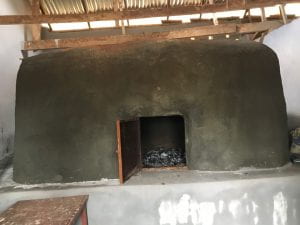Our first full day in Sierra Leone!
Our day began with a brief tour of the facilities here at World Hope International, our primary partners in-country. A World Hope employee, named Musa, then took us to the bakery that was recently completed on the grounds. The bakery, Betteh Bakery was just recently completed and workers are going through training before the facility becomes functional. Primarily built for the purpose of making bread, the facility’s oven (pictured below) will be perfect for cooking our muffins and potentially dehydrating ingredients for the bouillon cube. Most of the other equipment inside would not be necessary for the project.
Following our visit to the Betteh bakery, we travelled to a facility overseen by Musa where disabled workers work on various crafts including: metalwork, woodwork, and farming of cassava, ground nuts, ginger, and development of cornflower and palm oil. This was important insight for both of the malnutrition groups, as it showed us that most of our ingredients are readily available. We also came across a possible new ingredient. The moringa leave is very common here in Sierra Leone and is believed to be one of the next superfoods. The leaves are high in both Iron and Vitamin A. The leaves can be ground down to a flower and perhaps mixed into our products. While there, Musa, who oversees social ventures at World Hope, explained that he has the resources to set us up with suppliers for a lot of the ingredients our recipes use, which answered a lot of our supply chain questions very early.
Finally after returning from the visit, we went downtown to explore the markets.
Once again our ingredients were confirmed to be available in the markets. We received our money towards the end of the day and plan to figure out the cost of the ingredients most likely tomorrow. We also travelled to a supermarket to see the price of certain ingredients that we were thinking about incorporating into our recipes. For example, we looked into using coconut milk as a base for the pudding product. As expected, the prices were too steep to include in the products.
All in all, we had an extremely productive first day here. In Khanjan’s words, we really “hit the ground running” and are excited to keep moving forward during the next few days.


